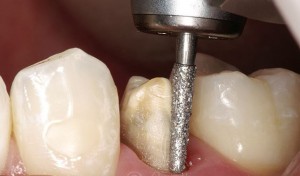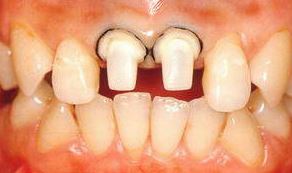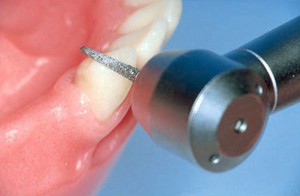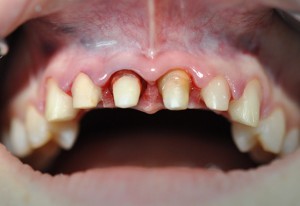Preparation of teeth under the crown

The preparation or turning of teeth under the crowns is one of the stages of prosthetics, which is the removal of the hard tissues of the tooth in order to prepare its surface for fixing the structure.
Until recently, the preparation procedure was quite painful and lengthy.
Thanks to modern anesthetics and the perfection of tools, the time of the procedure was reduced.
Do you always grind your teeth?
Unfortunately, this stage of prosthetics is a must.
In order for the crown to be correctly fixed on the tooth, it must be in maximum contact with it.
- But the natural shape of the tooth is not ideal and has convex shapes. When turning, the excess parts of the enamel are polished and the tooth is given the correct geometric shape. A crown can easily be worn on such a prepared tooth.
- In addition, the dental structure has a certain thickness, which must also be taken into account so that it does not cause discomfort and does not interfere in the mouth.
- During tooth grinding, tooth decayed tissues are removed. This is very important so that later secondary caries does not develop under the crown, and tooth decay does not occur.
How to turn

Before preparation, anesthesia is performed.
If the vital tooth is grinded, then there is no need for anesthesia, except for the case if it is necessary to move the gums with a special thread.
During the preparation, the anatomical features of the teeth and the reaction of the soft tissues are mandatory.
Before the procedure, an X-ray examination is carried out, on the basis of which the dentist gets an idea about the structure of the patient’s teeth and the possible places for opening the tooth cavity.
Methods
Currently, several techniques are used to grind a tooth under a crown.
Ultrasound preparation
The advantages of this technique:
- The minimum pressure of the working tips on the dental tissue.
- A small amount of heat does not cause overheating of dentin and enamel.
- The absence of pain during the procedure.
- Chips and cracks do not form on the walls of the pin.
- It does not adversely affect the pulp.
Laser turning
Pulse lasers can be used to prepare teeth.
Advantages of the laser technique:
- Silent operation of the equipment.
- Safety manipulation.
- Lack of strong tissue heating.
- The speed of the preparation.
- The complete absence of pain.
- No cracks or chips of pin structures occur.
- Lack of possibility of infection.
Tunneling tooth preparation under the crown

- Turbine dental units, which are widely used by dentists, allow you to adjust the speed of work and use diamond and metal tips.
- The quality of the equipment affects the end result.
- The use of worn tools is fraught with significant overheating of tissues, which increases the risk of further tooth decay.
During tunnel preparation, they try to maintain the largest possible volume of hard tooth tissue.
The main advantage of the method is the ability to control the volume of the removed layer and a clear prediction of the results.
Disadvantages of manipulation:
- There is a possibility of overheating of the tooth tissue, and if the amount of anesthetic was insufficient, pain may occur.
- If the procedure is not followed, injury to the surrounding gums is possible.
- If low-quality tools are used, then there is a high probability of the appearance of cracks and micro-chips of tooth tissue.
Air Abrasive Turning
An air mixture containing abrasive powder is used for preparation. The mixture, getting under great pressure on the surface of the tooth, causes fine destruction of hard tissues, and the removal of dental dust.
Advantages of the technique:
- High speed, as well as the simplicity of the tooth turning procedure.
- The absence of pain and tissue overheating.
- There is no negative effect on the pulp, as there is no vibration.
- The ability to maintain the maximum amount of hard tissue.
Chemical preparation
Chemical substances (most often acids) are used to remove hard tissues. They soften the tissue with their subsequent removal.
The disadvantage of the procedure is the duration, which can reach half an hour.
This method has found wide application in prosthetics with crowns of primary teeth in children's practice.
Benefits:
- There is no thermal damage to the tooth.
- Anesthesia is not required, since the procedure is painless.
- Microcracks and chips are not formed on the enamel.
- Due to the fact that there is no sound of a working drill, the patient feels comfortable.
Video: “Dissection of incisors, part 1”
Types of ledges

Tooth turning with a step is a prerequisite for fixing the crown.
Preparation without a step is a violation of prosthetics standards, since the crown will not fit snugly against the surface of the tooth, which can cause serious complications as a result.
Depending on the type of crown, the step can be:
- Knife-shaped ledge is the most commonly used type, the width of which is 0.3-0.4 mm. It is used when teeth are prepared under solid cast crowns. and when turning inclined teeth.
- For ceramic-metal prosthetics, a rounded chamfer ledge will be more relevant. Its thickness is 0.8-1.2 mm.
- The most uneconomic type of ledge, which requires mandatory depulpation, is the shoulder (Shoulder). The width of this ledge is 2 mm. However, this method contributes to a more solid fixation of the crown and has a high aesthetic performance.
Features of preparation for crowns
- Turning teeth under solid metal structures starts from the side surfaces, which prevents damage to adjacent teeth. Then evenly grind up to 0.3 mm of hard tissue.
- Under ceramic-metal crowns, the preparation is performed with preliminary depulpation. Then, 2 mm of tissue is removed from each side of the tooth with the obligatory creation of a ledge.
- In the process of tooth preparation, a rounded ledge is formed under the porcelain crown, immersed in the gum to 0.1 mm. The cult is given a cylindrical or conical shape.

Photo: Teeth turned on zirconium crowns - Preparation of a tooth under a plastic crown, generally similar to porcelain crown turning technology
- When turning along a zirconium crown, a shoulder and rounded ledge are formed.For chewing teeth, tissue removal should not exceed 0.6 mm, and for teeth of the anterior group - 0.3 mm.
- Tooth preparation for a stamped crown implies giving it a cylindrical shape. It is advisable to start turning with a contact surface. The thickness of the removed layer of hard tissue depends on the size, anatomical features and the position of the tooth in the row and is approximately 0.2-0.3 mm.
Does it hurt to grind your teeth
The preparation procedure with adequate anesthesia is painless.
But, in some cases, after the termination of the action of anesthesia, pain can occur in both the tooth and the gum.
The causes of pain can be as follows:
- If a too large layer of hard tissue on the vital tooth is removed. As a result, there is very little hard tissue over the pulp and the tooth reacts not only to the intake of cold or acidic food, but also to touch. In this case, it may be necessary to cement the thinned area or install a temporary crown on the stump of the tooth.
- In order for the doctor to have a sufficient overview of the working area, when turning a tooth with a ledge, the gum edge is moved away with a special thread. The presence of a thread between the tooth and gum leads to compression of the soft tissues, causing their soreness and swelling. Within one to two days, these sensations pass on their own.
- The occurrence of pain in the tooth some time after turning, may indicate the development of inflammation of the pulp or periodontal.